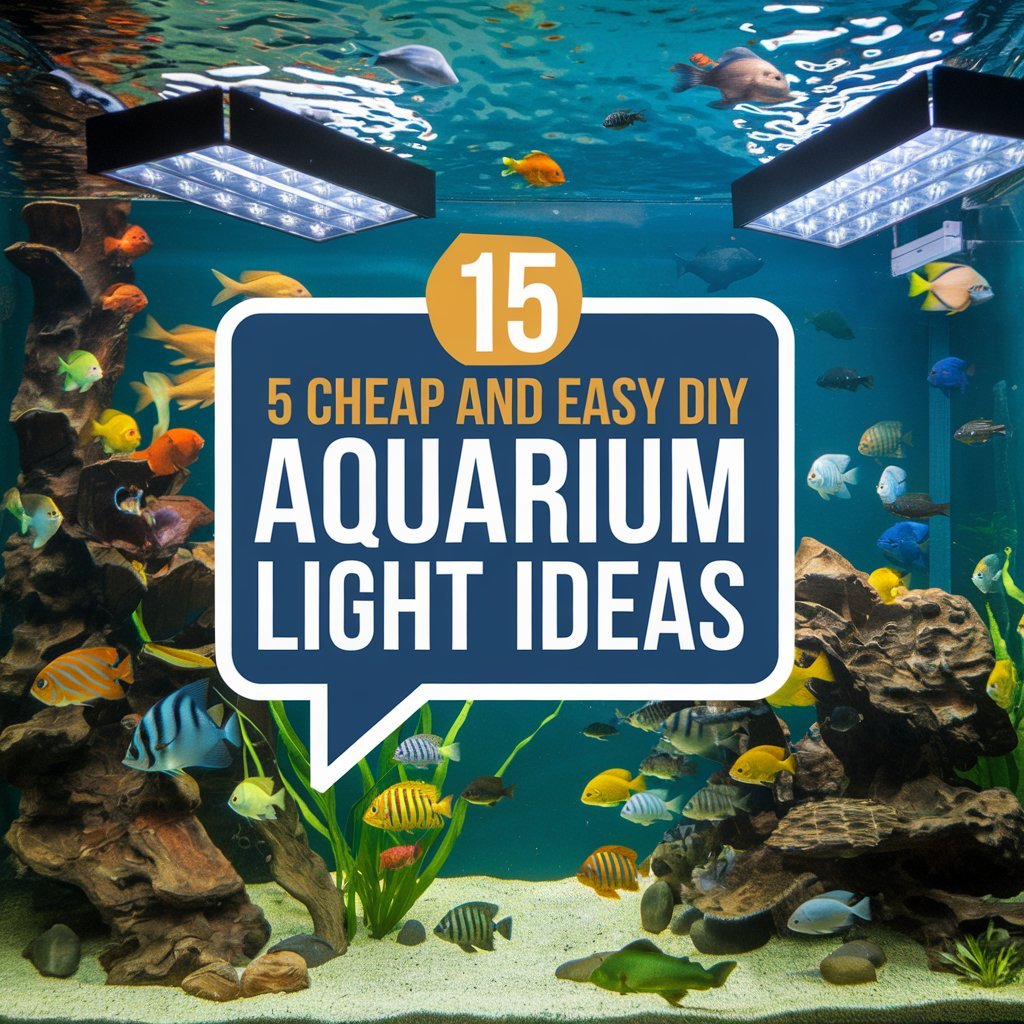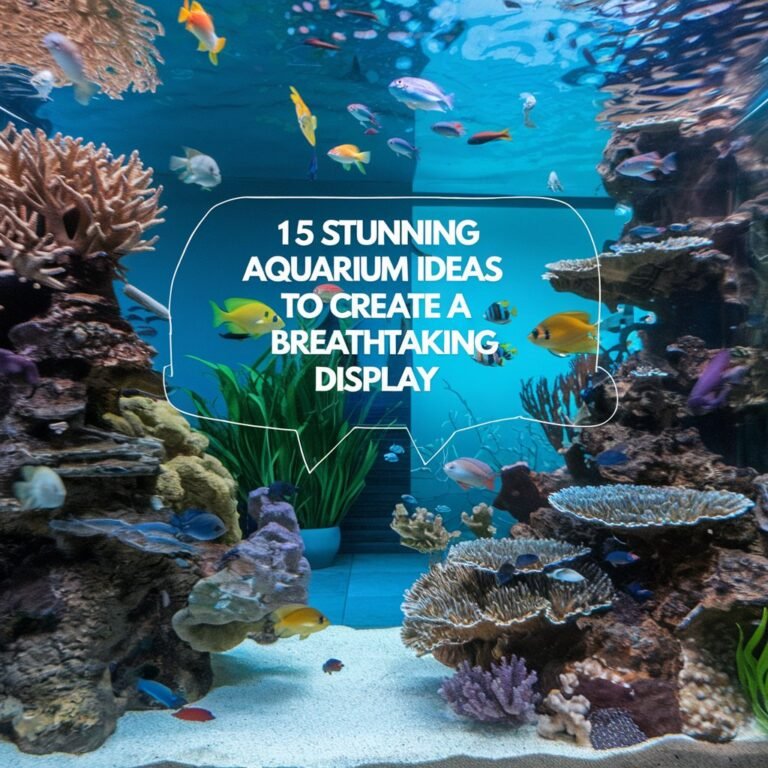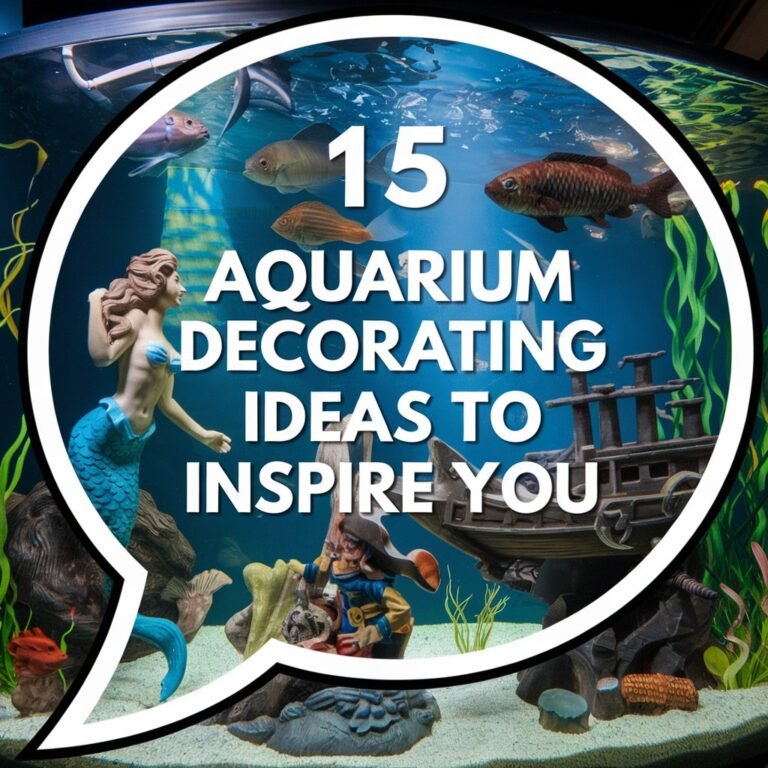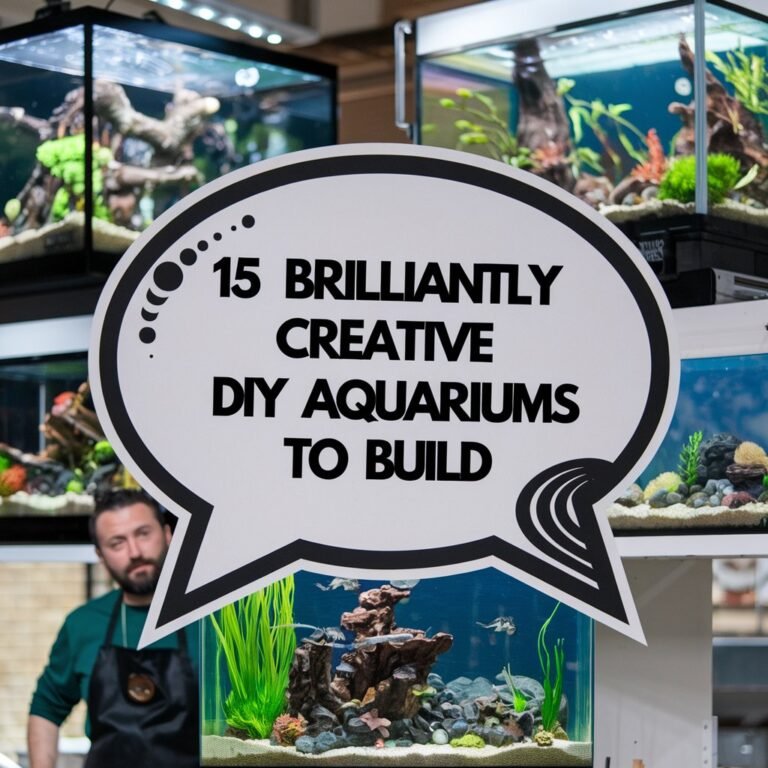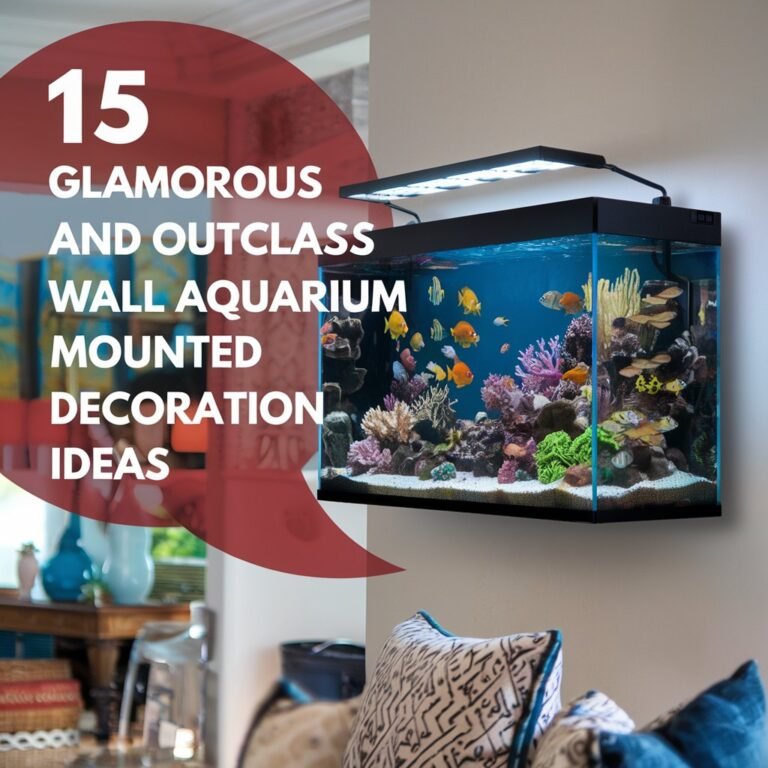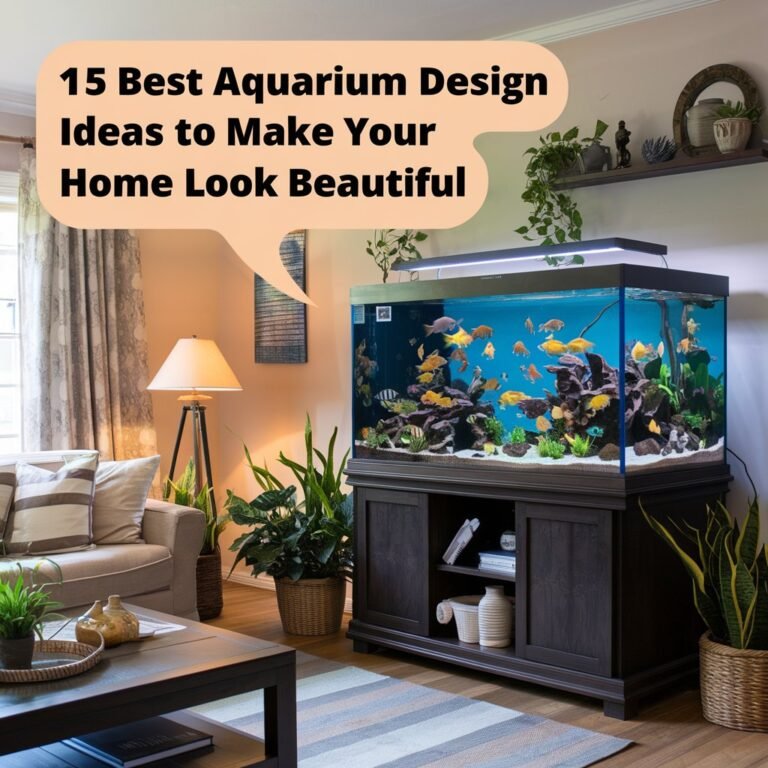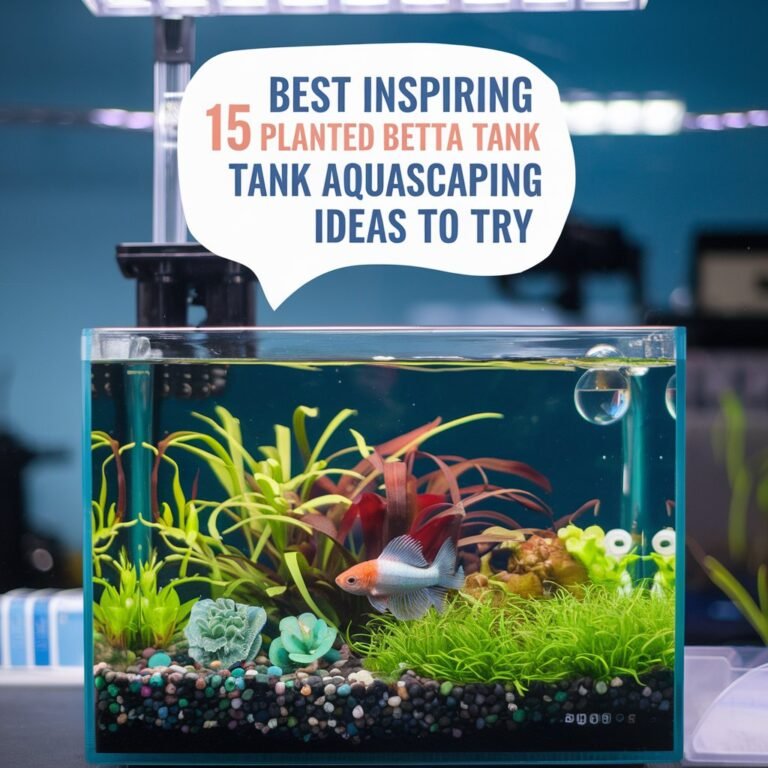15 Cheap and Easy DIY Aquarium Light Ideas
You’re looking to upgrade your aquarium’s lighting system without breaking the bank. You’ve come to the right place. With the right materials and a bit of creativity, you can create a stunning and functional lighting system that enhances your aquarium’s visual appeal and promotes healthy plant growth.
From repurposed household items to innovative DIY solutions, there are plenty of affordable options to choose from. But which ones are worth your time and effort? Let’s take a closer look at the top DIY aquarium light ideas for 2024 and explore how you can bring your aquarium to life.
In A Nutshell

- Use LED strip lighting kits with high waterproof ratings and suitable color temperatures for aquatic life.
- Create a DIY mason jar aquarium light using an LED strip and a few other materials for a unique solution.
- Repurpose old desk lamps or fluorescent tubes to create a custom and cost-effective aquarium lighting system.
- Design a customized PVC pipe lighting system to meet the specific needs of the aquatic environment.
- Utilize energy-efficient LED lights with high Energy Star ratings for a cost-effective and environmentally friendly solution.
LED Strip Lighting Kit
How can you create a cost-effective and energy-efficient lighting solution for your aquarium?
One option is to use an LED strip lighting kit, which can be customized to fit your aquarium’s specific needs.
When selecting an LED strip, consider the color temperature and spectrum that best suits your aquatic life. LED colors range from 2700K (warm white) to 6500K (cool blue), with some strips offering RGB or adjustable color options.
Look for strips with a high waterproof rating, such as IP67 or IP68, to guarantee they can withstand the humid environment surrounding your aquarium.
These ratings indicate the strip’s ability to resist water and dust ingress. Additionally, choose a strip with a suitable length and width to cover your aquarium’s dimensions.
Most LED strips are flexible and can be cut to size, making them easy to install.
To guarantee peak performance, pair your LED strip with a suitable power supply and controller.
Many kits include these components, but you may need to purchase them separately.
Repurposed Desk Lamp Conversion
Converting a repurposed desk lamp into an aquarium light can be a budget-friendly and creative solution for your aquatic setup.
When selecting a desk lamp, look for one with adjustable arms and a compact design that won’t obstruct your view. Choose a lamp with a compatible wattage and type of bulb, such as T8 or T10, which are suitable for aquarium use.
Verify the lamp is designed for use with a dimmable or non-dimmable ballast, depending on your specific needs.
Consider the color temperature of the bulb when selecting a lamp, as different temperatures can affect plant growth and color rendition.
A color temperature of 6500K to 7500K is ideal for most aquatic plants.
Cord management is also vital when repurposing a desk lamp. Secure the cord with cable ties or clips to prevent it from coming into contact with water or getting damaged.
Use a GFCI outlet to prevent electrical shock, and verify the lamp is placed safely above the aquarium to avoid water splashing onto the lamp.
DIY T5 Lighting System
A DIY T5 lighting system offers a versatile and energy-efficient solution for your aquarium, allowing you to customize the lighting setup to meet the specific needs of your aquatic environment.
By building your own T5 lighting system, you can choose the type and number of tubes you need, as well as the reflector design that suits your tank’s dimensions.
When building your DIY T5 lighting system, start by selecting the right tube holders.
You can use commercially available holders or create your own using materials like PVC pipes or aluminum extrusions.
Make sure the holders are adjustable and can accommodate the length of your T5 tubes.
Next, design a reflector that maximizes light output and minimizes light loss.
You can use materials like aluminum foil, reflective Mylar, or polished aluminum sheets to create a custom reflector.
A well-designed reflector can increase light output by up to 50%, making it an essential component of your DIY T5 lighting system.
Consider the shape and size of your tank when designing the reflector, and make sure it’s securely attached to the tube holders to prevent damage or misalignment.
Fluorescent Tube Upcycle
By repurposing an old or broken fluorescent light fixture, you can upcycle the components into a unique aquarium lighting system that reduces waste and saves money.
Start by identifying the fluorescent tube length and material. Typical tube lengths range from 15 to 60 inches, with 18, 24, 36, and 48 inches being common. The tube material usually consists of glass, although some modern alternatives are made of plastic.
You can either reuse the existing tubes or purchase new ones.
To upcycle the fixture, remove any broken or non-functional components. Guarantee the electrical components are secure and safely wired to avoid electrical shock or fires.
Mount the upcycled fixture above your aquarium using a sturdy and adjustable frame, keeping it at a safe distance from the water.
For an energy-efficient solution, consider using LED retrofit kits, specifically designed for fluorescent fixtures.
These kits usually consist of an LED driver, mounting clips, and a compatible LED strip or module.
With this DIY upcycle project, you’ll be part of the eco-friendly movement, giving your aquarium the perfect lighting solution while minimizing your environmental footprint.
Solar Powered Aquarium Lights
Most aquarium owners are now opting for solar-powered lighting systems, which harness renewable energy to illuminate their aquatic ecosystems.
You can create your own solar-powered aquarium light by using solar panels to generate electricity. These panels convert sunlight into electrical energy through photovoltaic cells, which can then be stored in a battery for later use.
When choosing solar panels, consider the wattage and voltage required to power your aquarium lights.
To build a solar-powered aquarium light, you’ll need a solar panel, a rechargeable battery, a charge controller, and an LED light strip.
Connect the solar panel to the charge controller, which regulates the energy flow to the battery.
The battery then powers the LED light strip, providing a sustainable and energy-efficient lighting solution for your aquarium.
This setup allows you to harness renewable energy and reduce your reliance on non-renewable energy sources.
Mason Jar Aquarium Light
The mason jar aquarium light is a creative, low-cost DIY solution that utilizes readily available materials to create a unique and functional lighting system for your aquarium.
This innovative lighting solution incorporates a mason jar, an LED strip, and a few other materials to produce a stunning display of Mason magic.
You’ll need a mason jar, a LED strip, a battery pack, some wire, and a waterproof adhesive to get started.
Begin by carefully selecting an LED strip that matches the desired color temperature and lumens output for your aquarium.
Cut the strip to the desired length, then carefully attach it to the inside of the mason jar using a waterproof adhesive.
Verify that the strip is evenly spaced and secure to avoid any damage.
The Jar aesthetics will create a mesmerizing visual effect, as the LED light diffuses through the glass jar.
Connect the LED strip to a battery pack, then attach it to the mason jar’s lid or base, depending on your desired configuration.
You can adjust the positioning and lighting levels to suit your aquarium’s needs, and voila!
Your Mason Jar Aquarium Light is complete, ready to provide an enchanting ambiance for your aquatic world.
Underwater LED Tape Lights
With an emphasis on creating an immersive aquatic environment, underwater LED tape lights can be a valuable addition to your aquarium’s lighting system.
These flexible strips of LED lights are designed to be submerged underwater, providing a unique and mesmerizing visual effect.
When choosing underwater LED tape lights, consider the color options available. You can select from a range of colors, including white, blue, and RGB, to create the desired ambiance for your aquarium.
When selecting underwater LED tape lights, verify they’ve a waterproof design to prevent damage from water exposure.
Look for lights with a high IP rating, such as IP67 or IP68, which indicates their ability to withstand being submerged in water.
Additionally, consider the adhesive backing and verify it’s suitable for the surface you plan to attach the lights to.
PVC Pipe Lighting System
You can elevate your aquarium’s lighting system by repurposing PVC pipes as a unique and functional lighting fixture.
This DIY project allows you to customize the lighting setup according to your aquarium’s specific needs.
To create a PVC pipe lighting system, start by selecting the right type of PVC pipes and pipe fittings that fit your aquarium’s dimensions.
You’ll need to choose pipes with a diameter that accommodates your desired lighting components, such as LED strips or T5 lights.
When designing your PVC pipe lighting system, consider the PVC aesthetics and how they’ll blend with your aquarium’s overall look.
You can use PVC pipes in various colors or add a coat of paint to match your aquarium’s decor.
Use pipe fittings to create a sturdy and adjustable lighting fixture that can be easily mounted above your aquarium.
Make sure to leave enough space between the lights and the water surface to prevent overheating and promote even light distribution.
With a PVC pipe lighting system, you can achieve professional-looking results without breaking the bank.
Glass Jar Aquarium Light
How can you repurpose a simple glass jar to create an attractive and functional aquarium lighting system?
You can start by selecting a suitable glass jar that complements your aquarium’s style. Choose from various jar shapes, such as cylindrical, spherical, or oval, to create a unique glass decoration that enhances your aquarium’s aesthetic appeal.
When selecting a jar, consider its size, material, and color. A clear glass jar allows for maximum light transmission, while a colored jar can create a warm ambiance.
Confirm the jar is large enough to accommodate your lighting components, such as LED strips or a small LED light.
To create your glass jar aquarium light, start by cleaning and drying the jar thoroughly.
Then, wrap the LED strips or place the LED light inside the jar, securing it with a non-conductive material like silicone or epoxy.
Finally, connect the lighting components to a power source and place the jar above your aquarium.
This DIY lighting system not only provides adequate lighting for your aquatic plants and fish but also adds a touch of elegance to your aquarium setup.
Energy Efficient LED Lights
Several key factors make energy-efficient LED lights an attractive option for aquarium lighting.
They’re a cost-effective solution that can help you save money on your energy bills while also reducing your environmental footprint. When shopping for energy-efficient LED lights, look for products with high Energy Star ratings, which indicate that they meet energy efficiency standards set by the U.S. Environmental Protection Agency.
LED lights are also highly customizable, allowing you to choose the perfect color temperature for your aquarium.
Color temperatures range from 5000K to 20000K, with lower temperatures producing warmer, more yellowish light and higher temperatures producing cooler, bluer light. For aquariums, a color temperature of 10000K to 15000K is often recommended, as it promotes healthy plant growth and enhances the natural colors of your fish.
DIY Aquarium Canopy Lights
Creating a DIY aquarium canopy with lights is a cost-effective and customizable way to enhance the aesthetic appeal of your aquatic setup while also providing essential lighting for your aquatic plants and inhabitants.
To start, you’ll need a few basic materials such as a wooden or PVC frame, LED strips or aquarium-specific lighting, a power source, and some wiring. Begin by designing and building the canopy frame to fit your aquarium’s dimensions, taking care to ensure it’s sturdy and waterproof.
Next, choose your lighting option and install it within the canopy, making sure to leave enough space for heat dissipation and easy maintenance. Finally, connect the lights to a power source and test them to ensure they’re working properly.
With a little creativity and some basic DIY skills, you can create a beautiful and functional aquarium canopy that not only enhances the appearance of your tank but also provides a healthy environment for your aquatic life to thrive.
Recycled Bottle Aquarium Light
One creative way to reduce waste and create a unique aquarium lighting system is by repurposing an old plastic bottle.
You’ll need a 2-liter or 1.5-liter plastic bottle, some wire, a low-voltage power source, and an LED light strip or a small LED light.
Start by cutting the bottle in half and flipping the top half upside down to create a mini-dome. This will help distribute the light evenly throughout your aquarium.
Next, wrap the LED light strip or attach the small LED light to the inside of the bottle cap. You can use plastic wrapping or electrical tape to secure the wires and keep them organized.
Attach the bottle cap to the top of the mini-dome, making sure it’s secure and won’t topple over. Place the mini-dome over your aquarium, and you’ll have a functional and eco-friendly lighting system.
You can customize the color and intensity of the light by using different LED strips or lights. This DIY project isn’t only budget-friendly but also a great way to reduce waste and create a unique conversation piece for your aquarium.
Low Wattage LED Lighting
When choosing a low-wattage LED lighting system for your aquarium, consider the specific needs of your aquatic environment.
Low-wattage LED lighting is ideal for smaller aquariums or those with low-light plants and animals. You can use individual LEDs or a pre-assembled LED strip to create a customized lighting system.
Dimmable LEDs are a great option for low-wattage LED lighting, as they allow you to adjust the light intensity to meet the needs of your aquarium.
This feature is especially useful for simulating day-night cycles and promoting healthy growth in your plants and animals. Additionally, dimmable LEDs can help reduce energy consumption and prolong the lifespan of your lighting system.
To add some visual interest to your aquarium, consider incorporating colorful accents into your low-wattage LED lighting system.
You can use colored LEDs or add a color-changing effect to create a unique and engaging display. By choosing the right low-wattage LED lighting system and customizing it to meet your needs, you can create a thriving and visually appealing aquarium environment.
With a little creativity, you can achieve professional-looking results without breaking the bank.
Custom Aquarium Light Bar
A custom aquarium light bar offers you a high degree of flexibility and control over the lighting in your aquatic environment.
By designing and building your own light bar, you can tailor the lighting to meet the specific needs of your aquarium’s inhabitants and enhance its overall aesthetics. This approach allows you to choose the type, color, and intensity of the lights, as well as their placement and distribution.
When building a custom light bar, consider the importance of light diffusion.
You can achieve this by using a diffuser, such as a frosted glass or acrylic cover, to scatter the light and reduce hotspots. This helps to create a more even and natural lighting effect, which can enhance the aquarium’s visual appeal and promote healthy plant growth.
To create a custom light bar, you’ll need to select a suitable enclosure or housing, choose your desired lighting components, and design a mounting system.
You can use a variety of materials, such as aluminum or PVC, to build the light bar and attach the lights. With careful planning and attention to detail, you can create a custom light bar that meets your aquarium’s unique needs and enhances its overall appearance.
Affordable LED Lighting Grid
Building on the concept of custom aquarium lighting, you can achieve a high level of illumination control with an affordable LED lighting grid.
This setup involves arranging multiple LED strips or modules in a grid pattern to provide even light distribution across your aquarium. By doing so, you can create a highly customizable lighting system that caters to the specific needs of your aquatic plants and animals.
To create an affordable LED lighting grid, you’ll need to select the right LED strips or modules, a power supply, and a control system.
Consider using addressable LED strips, which allow you to program different light patterns and colors. When designing your grid, pay attention to light distribution and grid patterns.
A square or rectangular grid pattern can provide even light distribution, while a triangular or hexagonal pattern can create a more natural, dappled effect.
Frequently Asked Questions
What Are Aquarium Light Spectrum Requirements for Different Fish Species?
When setting up your aquarium, you’ll need to ponder fish vision and the light spectrum requirements for different species, as some, like cichlids, benefit from intense color enhancement, while others, like nocturnal fish, prefer dimmer, blue-shifted light.
How Do I Determine Aquarium Lighting Duration and Timing?
To determine aquarium lighting duration and timing, you’ll want to establish light cycles mimicking your fish’s natural habitats. Research specific requirements and adjust your timer settings to create day and night cycles accordingly.
Are Homemade Aquarium Lights Safe for Fish and Aquatic Plants?
You must consider Light Safety when creating homemade aquarium lights, as DIY Risks include electrical shock, overheating, and inadequate spectrum, which can harm fish and aquatic plants if not properly addressed and mitigated.
Can I Mix Different Light Types in My DIY Aquarium Setup?
You can mix different light types in your DIY aquarium setup by employing light layering and color blending techniques, creating a unique spectrum that caters to your aquatic life’s specific needs and enhances visual appeal.
How Do I Protect Aquarium Lights From Water Damage and Corrosion?
You’ll want to protect your aquarium lights from water damage and corrosion by applying waterproof coatings and installing moisture barriers around electrical components to prevent short circuits and guarantee a safe, long-lasting setup.
FInal Verdict
You’ve explored 15 innovative DIY aquarium light ideas, each offering a unique blend of energy efficiency, customization, and cost-effectiveness. From repurposed desk lamps to solar-powered systems, these projects cater to various aquarium sizes and styles.
By implementing these ideas, you’ll enhance your aquarium’s visual appeal, promote healthy plant growth, and showcase vibrant fish colors. With these DIY solutions, you can create a stunning and functional lighting system without breaking the bank.
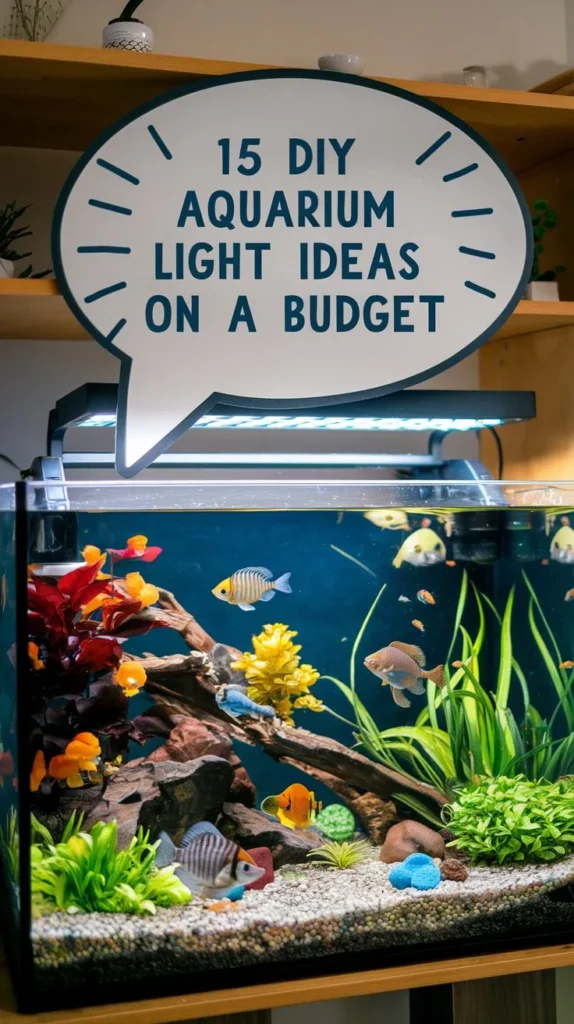
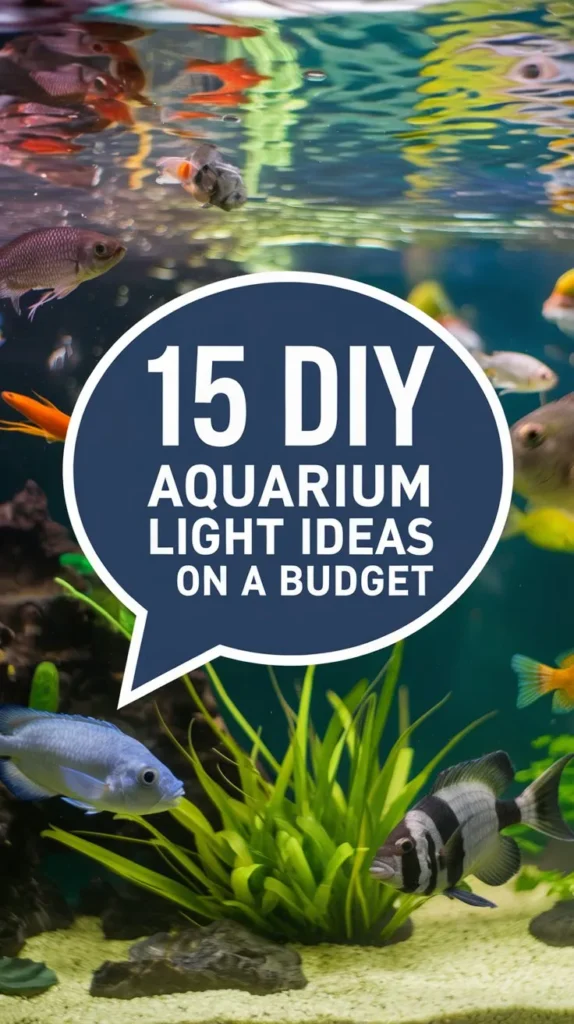
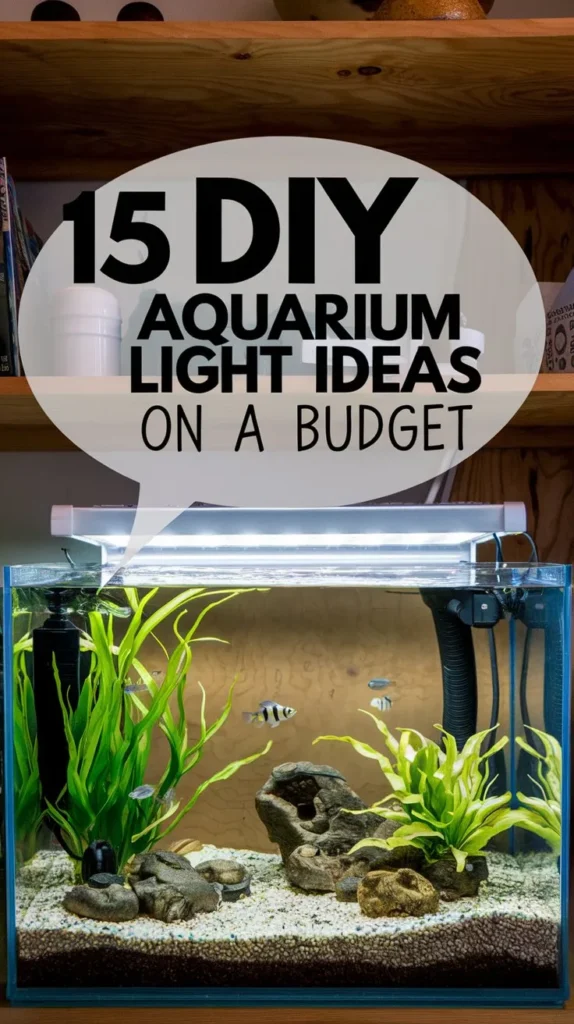

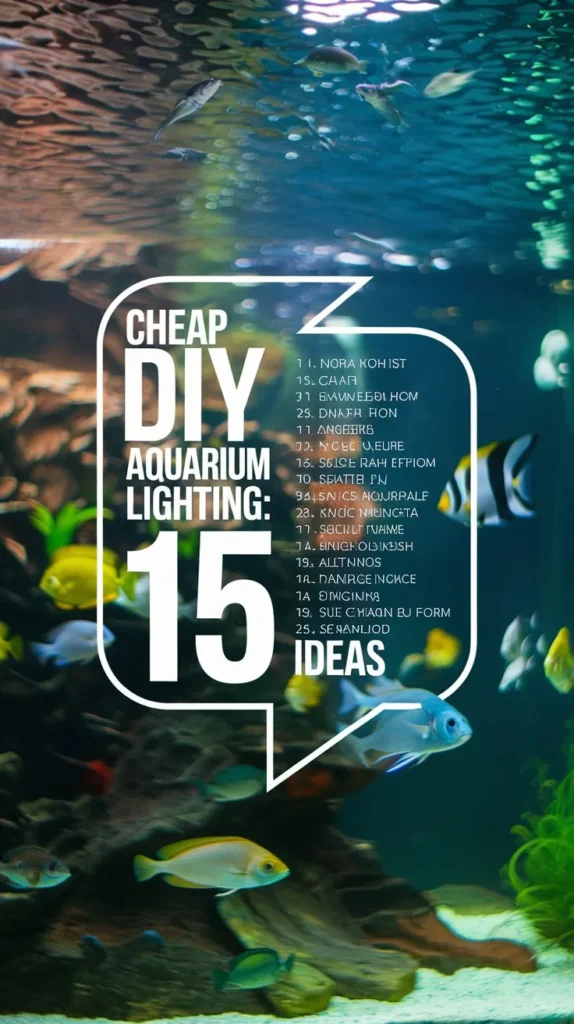

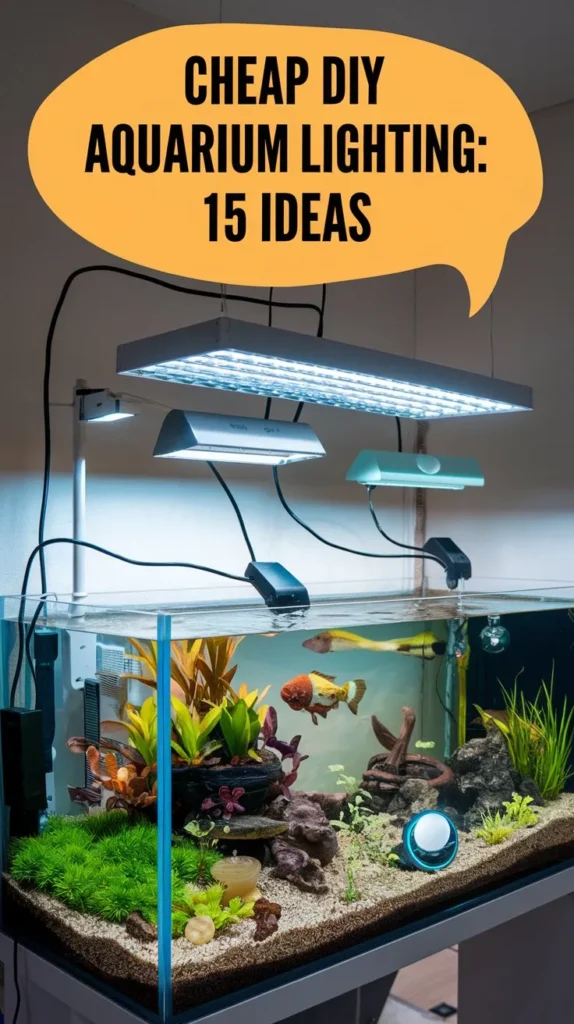
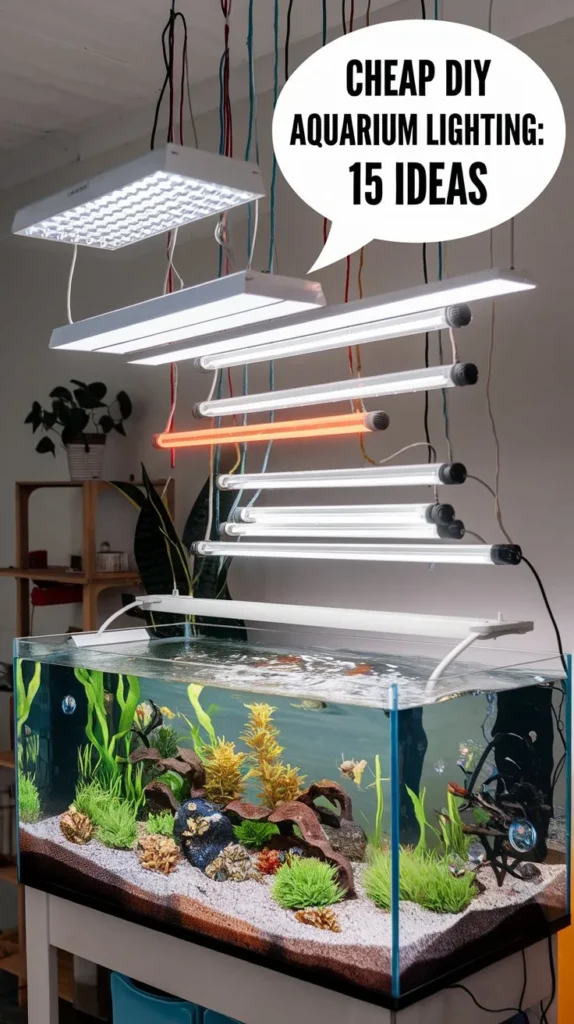
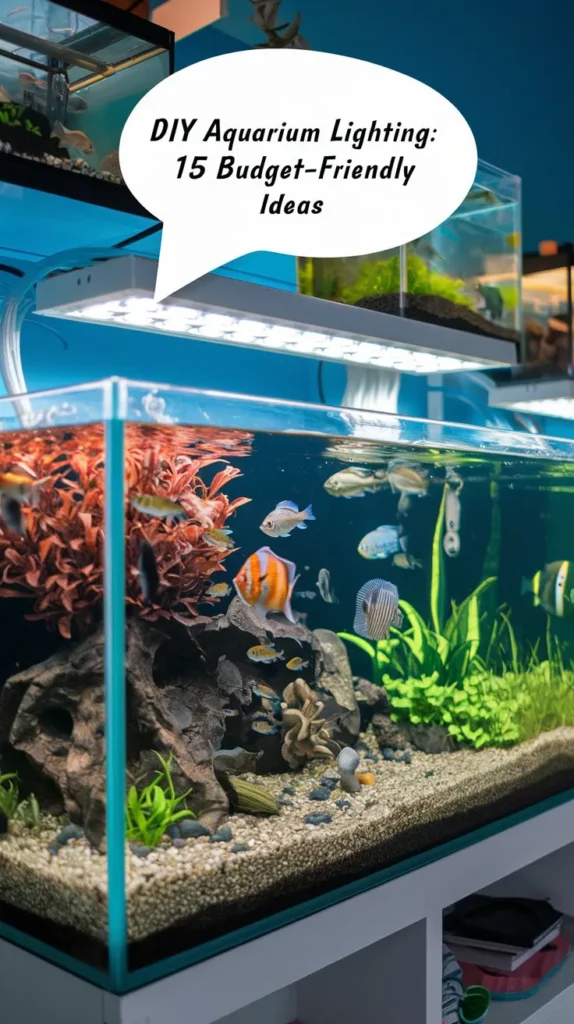
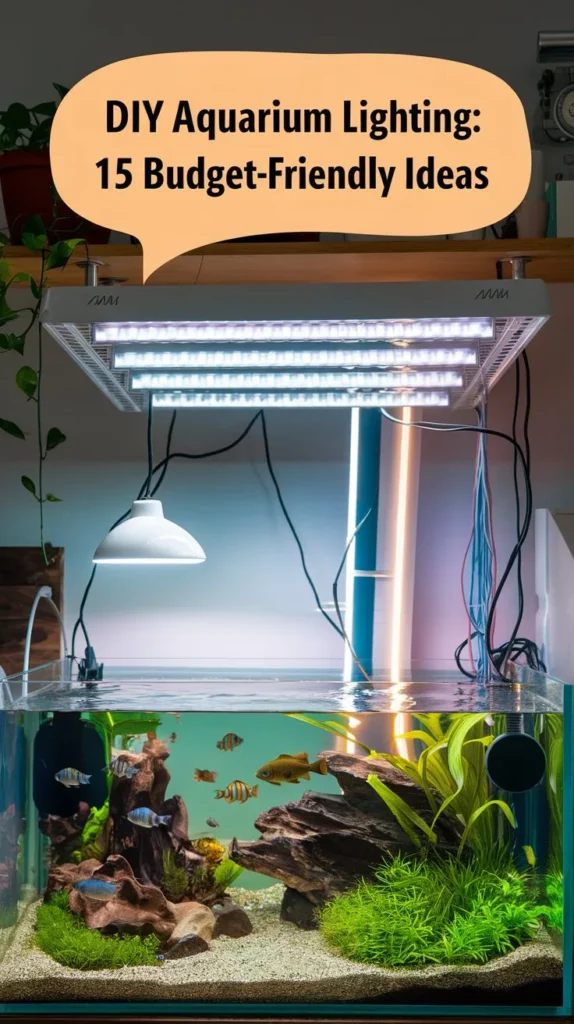

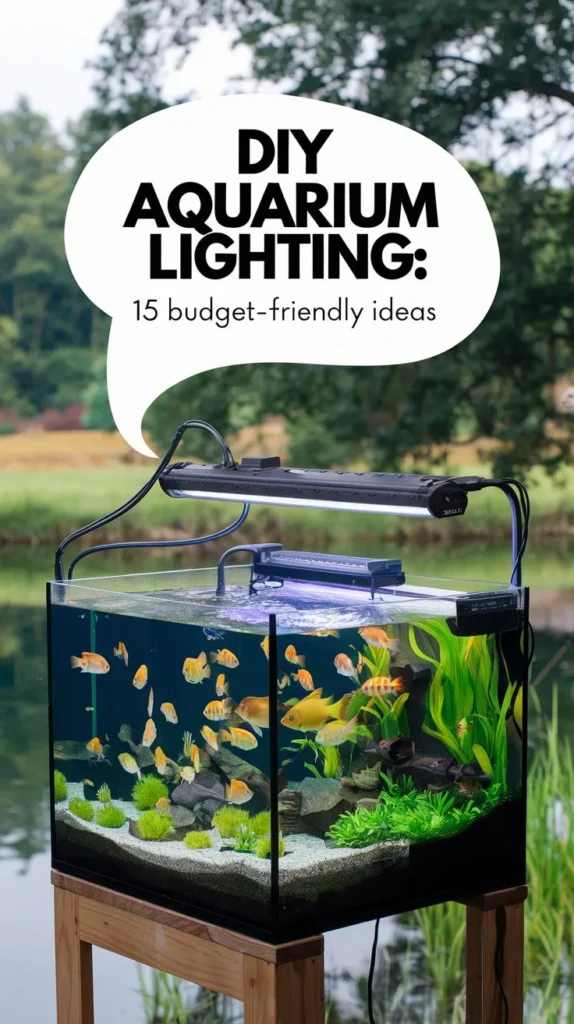

Hello, I’m Aria Cooper, the heart and soul behind Swimmy Buddies. As a devoted fish aficionado, I share my aquatic adventures and expertise to inspire your own underwater explorations. 🐠🌊

